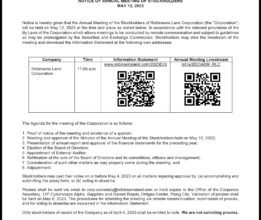A few hints in automotive’s direction in 2023

As a brand new year approaches and the world is slowly adapting and preparing to post-pandemic transformations, the automotive industry has seen the positive light as well.
The pandemic brought several changes like evolving mobility, changing business models and customer experiences, and new technology requirements. As the industry slowly adopts to these changes, they are also opening opportunities that will help them recover and bounce back.
According to Brand Finance, a brand valuation consultancy, the automotive industry is recovering from the effects of the pandemic, as automotive sales and values increases, together with heightened push in innovations, investments, and demand.
“Growth in savings as well as sustained relatively low interest rates have pushed up demand for all types of goods – cars included,” Alex Haigh, managing director for Asia Pacific at Brand Finance, noted in their latest overview of industry trends on their website.
Citing strategic market research firm Euromonitor, Mr. Haigh highlighted unit sales volumes in 2022 are expected to be around 78 million units, beating the pre-pandemic 2019 levels, and profits also rose on average across original equipment manufacturers this year, with many making record numbers.
In light of such observations, the overall impact of the pandemic on the automotive sector is initially being reversed, which pave a fine way for significant trends to further and meaningfully boost such recovery.
Mobility as a service
The automotive industry also has been seen to be venturing into mobility as a service (MaaS), which refers to the “concept of shifting transportation solutions to an on-demand service,” according to fleet and mobility management software provider Smartrak.
MaaS offers transportation services to meet the transportation needs of their consumers whenever and wherever they need them. Examples of MaaS include brands like Grab, Uber, and Lyft, among others.
“The phrase ‘mobility as a service’ is a broad term for service that allow consumers to buy short-term mobility. It provides an alternative to purchasing personally owned vehicles. Examples of these services include ride-sharing platforms and short-term electric bike rental programs, just to name a few,” ThomasNet, an industrial sourcing platform, said in its list of must-know auto industry trends published on its website.
Moreover, the shift to MaaS, which include ridesharing apps, ‘peer-to-peer’ rental services, and micro-mobility services, can provide wider range of options to go from one place to another, which in turn can help lessen traffic.
According to Smartrak, organizations can use MaaS as a way to reduce the number of vehicles owned by the organizations, an alternative transportation model to reduce and save the costs and budget of the organization, as well as a business strategy in recovering costs related to fleet assets.
Rising use of green vehicles
The increasing demand for the use of eclectic vehicles (EVs) is seen to be part of the recovery of the automotive industry.
“Although demand looks positive across the industry, EVs are by the far the best performing drivetrain type in terms of relative growth. In 2021, about 6.4 million plug in electric vehicles were sold – an increase of over 100%. This represents a rise from 4.5% of all vehicles sold in 2020 to 9% in 2021,” Mr. Haigh of Brand Finance wrote.
As the demand for EVs is increasing, the actions of automotive companies are also seen to be growing.
“In response to this growing demand for electronic vehicles, automakers are doubling down on investments in green initiatives. They are working to improve the efficiency of existing models and exploring new ways to satiate demand for zero-emission vehicles,” ThomasNet explained.
The year also saw the adoption of zero-emission vehicles, which include battery electric vehicles and hydrogen fuel cell electric vehicles, which do not release any forms of greenhouse gases into the atmosphere when used.
This was observed by the 2022 Zero-Emission Vehicles Factbook published by research company BloombergNEF (BNEF). The factbook notes that “global momentum toward zero-emission road transport has continued to accelerate in 2022, with passenger electric vehicle sales on track for more than 10 million units, up from 6.6 million in 2021. Over 13% of new car sales globally in the first half of 2022 were electric, rising from 8.7% for all of 2021.”
“The adoption of zero-emission vehicles has already reduced oil consumption and carbon dioxide (CO2) emissions. Electric vehicles of all types, are expected to avoid almost 1.7 million barrels of oil use per day in 2022, up from 1.5 million barrels per day in 2021. These vehicles are currently eliminating 152 million metric tons of CO2 per year, with the biggest contribution coming from the large fleet of electric two- and three- wheelers in Asia,” BNEF said in Bloomberg Philantrophies’ website.
These vehicles, it added, are currently eliminating 152 million metric tons of CO2 per year, with the biggest contribution coming from the large fleet of electric two- and three-wheelers in Asia.
Digital transformation
The acceleration of digital transformation since the pandemic has been evident in the automotive industry with the use of e-commerce as a platform for automotive sales, as well as the further adoption of digital transactions. And in the years to come, these trends are expected to take further shape.
“Modern consumers have grown accustomed to making purchases by simply clicking a few buttons on their laptops or smart devices. As a result, they have come to expect that all transactions will be equally as efficient and frictionless. This expectation directly conflicts with the traditional car-buying experience, which typically takes hours to navigate,” ThomasNet noted.
In light of post-pandemic shifts and economic uncertainties, considering these trends can guide automotive companies towards surpassing disruptions and continuing building themselves back better towards full recovery in the following years. — A.K.S. Brillantes




